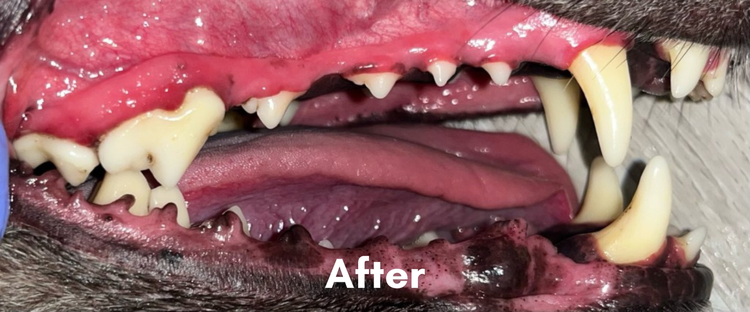Anesthesia-Free Teeth Cleaning for Your Dog: What to Know
Did you know that regular, professional dental cleaning is an essential part of your dog’s health routine? Yep, just like humans, dogs need dentist appointments to prevent teeth and gum disease.
If you’ve ever tried to brush your dog’s teeth with a traditional dog toothbrush and paste, you know how difficult it is to get their pearly whites clean while they’re wiggling and slobbering. That’s why many vets use anesthesia for dental appointments.
However, there is another option for many dogs: anesthesia-free teeth cleaning. And we offer these appointments with our certified dental clinician!
Why Professionally Cleaning Your Dog’s Teeth Semi-Annually is Important
Unfortunately, even if you routinely brush your dog’s teeth, bacteria still grows beneath the gum line. Semi-annual professional cleaning is the only way to prevent gum disease and tooth decay (or loss).
Periodontal disease, the most common doggy dental issue, is caused by the accumulation of plaque and tartar on your dog’s teeth, which triggers inflammation. It affects canine teeth and the surrounding structures, meaning their gums and bone. Ouch!
The Differences Between Anesthesia and No Anesthesia Teeth Cleanings
You guessed it, the main difference is that our dental appointments don’t include anesthesia. While anesthesia-free is a great option for many dogs, there are a few things to consider when choosing the type of dental procedure that will be best for your dog.
Natural Calming Solutions vs. Prescription Sedatives
At Happy Dog, we don’t use (or allow) pharmaceutical sedatives or medications before or during the anesthesia-free appointment. You can give your dog CBD products or natural calming supplements prior to their cleaning to help with jitters and anxiety, but your dog will be awake and not under the influence of any IV or inhaled medications.
This can be a major positive … IF your dog is generally even-tempered, relaxed, and comfortable with their mouth being touched. On the flip side, it can be a challenge if your dog is aggressive, very anxious, or gets stressed out when their teeth are being worked on.
Note: We strongly recommend doing a test run of any CBD product before booking your first anesthesia-free dental cleaning. Some dogs have an adverse reaction to CBD, so we want to be sure it calms your dog, instead of adding to their stress!
Pre-Appointment Tests and Labs
Anytime your dog is scheduled to go under anesthesia, you’re required to get lab work to ensure your pet’s internal organs can support the anesthesia. Since anesthesia isn’t part of our dental procedure, we don’t require any pre-lab work or tests.
Note: We do ask health-related questions and require a health release form to be completed before appointments, though.
Dental Procedure Costs and Recovery Time
Between the lab work and dental cleaning procedure, which is done at a vet’s office, you’re looking at spending between $700 and $1,400 for an appointment with anesthesia. Appointments typically last 4 to 8 hours and it can take up to 24 hours for your dog to be fully recovered from the procedure.
Because our cleanings are performed at our clinic and don’t require anesthesia-related equipment or pharmaceuticals, the appointment is only 60 minutes and costs a total of $300. And since your dog is fully awake for the entire cleaning, there is no recovery time necessary.
Here’s a Comparison Chart to Help You Decide Which Procedure is Best for Your Dog:
Is My Dog Eligible for An Anesthesia-Free Teeth Cleaning?
Many dogs are well-suited for non-sedated dental cleanings, depending on their health, breed, and temperament.
Before we book your appointment, we’ll go through our pre-screening qualifications to ensure a safe, reasonably stress-free appointment. We’ll talk to you about these 3 things:
Dog Breed: We cannot service Brachycephalic breeds, AKA scrunchy-face dogs, like, Frenchies, bulldogs, pugs, and boxers. Unfortunately, with these breeds’ respiratory issues, it’s not safe for us to do the anesthesia-free dental procedure.
Overall Health: Does your dog have any health concerns? What about heart conditions, such as a heart murmur? Out of abundance of caution for your dog’s health, we’re not able to perform the cleaning if your dog has a grade 3 heart murmur or higher.
Your Dog’s Temperament: Are they friendly? Are they anxious? Do they have any type of aggressive behaviors? How do they do with having their mouth/face touched?
Dogs with a history of aggression cannot be serviced. We can offer an herbal calming solution that is all-natural for dogs with anxiety. However, we don’t want to distress your dog, so if they have severe anxiety they may not be a good fit.
When is an Anesthetic Dental Cleaning Necessary?
Anesthetic appointments are required for:
Severe periodontal disease.
Tooth extractions. (Sedation is required to avoid severe pain and discomfort.)
Dogs with aggressive behavior or dogs who cannot relax enough to safely receive a non-anesthetic treatment.
Happy Dog’s No-Anesthesia, 10-Step Dental Procedure
Appointment Booking. Call us at 410-814-0964 to schedule an appointment. Because this is one of our most popular services, we collect a $150 non-refundable deposit when your appointment is made. If you need to reschedule, we can transfer the deposit to the new appointment.
Note: If the clinician can only get through part of the teeth cleaning, $85 will be refunded for the consultation/attempt.Paperwork Completion. We’ll ask you to complete our health release waiver that discusses your pet’s medical history and sign it.
Getting Your Pup Ready. We’ll lay your dog on its back or side, whichever is more comfortable. Smaller dogs are swaddled in a towel because wrapping them is a calming technique, plus it prevents them from squirming too much.
Pre-Treatment Oral Exam and Charting. Each tooth is assessed for mobility, fractures (broken or chipped areas), malocclusion (hitting other teeth or impaling the soft tissues of the mouth), and periodontal disease. We’ll note and record on your pet’s dental chart if there are missing, loose, fractured, or discolored teeth, periodontal pocket depths, or gingival recession and overgrowth (hyperplasia).
Note: If we see any advanced dental concerns, you’ll be referred to a vet for an anesthetic cleaning.Oral Rinse. Before the cleaning actually starts, we’ll rinse the oral cavity with a 0.12% Chlorhexidine solution to decrease the amount of bacteria in your dog’s mouth.
Cleaning. We’ll use hand instruments to remove plaque and calculus that has accumulated under the gum line, in between teeth, and on the root surface. When properly performed, these steps promote healing and re-adaption of the gingival (gum) to the tooth’s surface.
Polishing. No matter how careful we are during the removal phase, minor micro-abrasions of the tooth surface can occur. Polishing smooths out the defects and removes any plaque missed during the previous steps!
Irrigation. Diseased tissue and plaque are removed from the pocket between the gums and tooth by spraying water and/or disinfectant Chlorhexidine.
Post-Cleaning Exam. Your dog’s cleaned teeth are meticulously examined on all surfaces to be sure all plaque and tartar were removed.
Post-Cleaning Diagnostics. We’ll record everything from the dental procedure on your pet’s chart, and you’ll be given a report card to take home. Finally, you’ll receive follow-up recommendations, advice on their next dental cleaning, and at-home maintenance tips.



